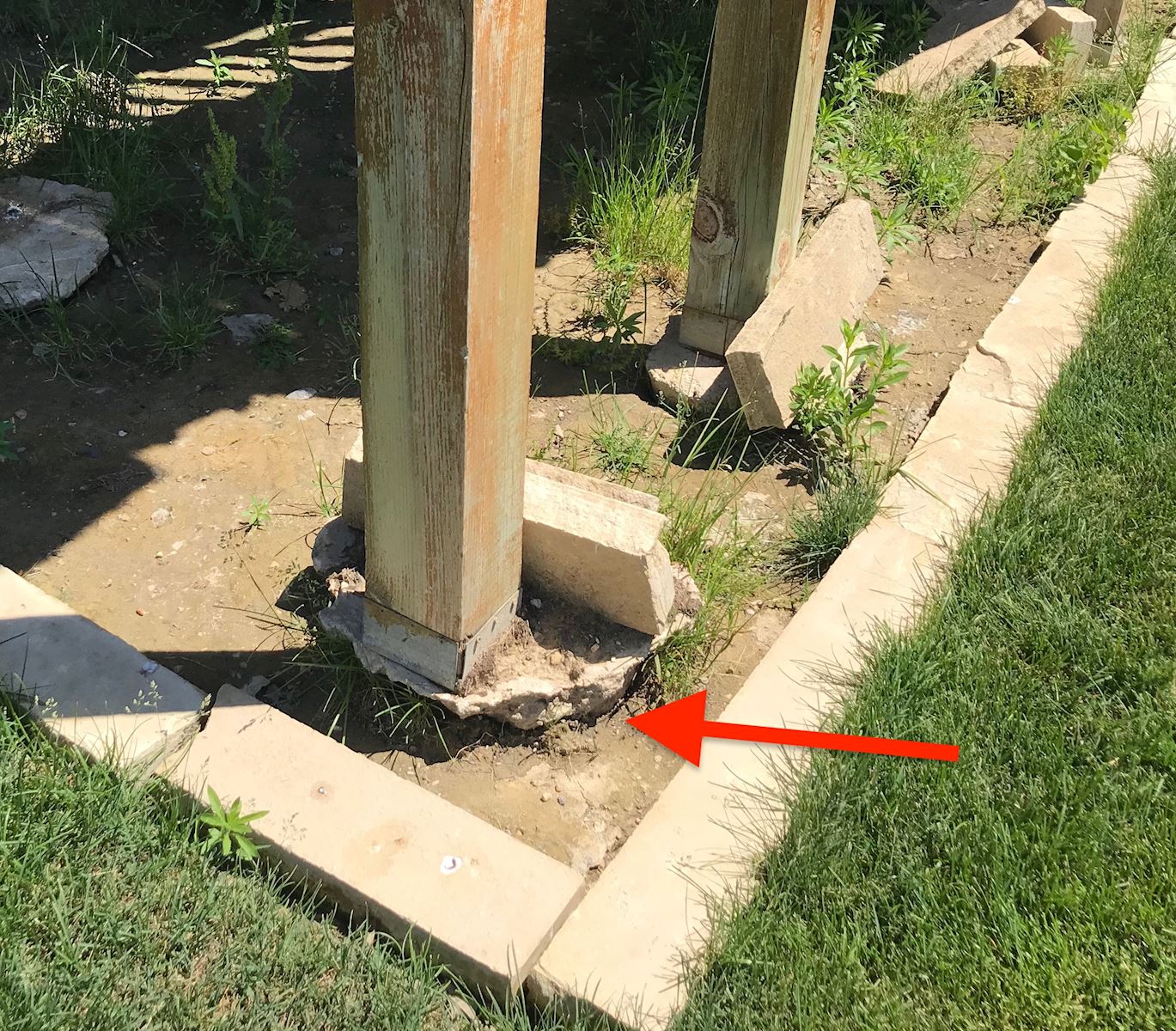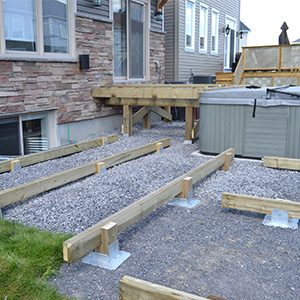Picking the Right Deck Footings for Stability and Sturdiness
When it pertains to constructing a deck, one of one of the most crucial decisions you will certainly make is choosing the appropriate footings for stability and longevity. The longevity and safety and security of your deck depend heavily on the sort of footings you pick, as they supply the crucial assistance and security to endure the test of time. With a myriad of choices offered, it can be overwhelming to figure out which footings are best fit for your certain demands. In this discussion, we will explore the numerous sorts of deck grounds, think about the vital variables to consider when choosing, and explore the benefits and drawbacks of different options. By the end, you will have a more clear understanding of the options handy and be far better furnished to make a notified choice for your deck project.
Kinds of Deck Grounds
These grounds consist of a cylindrical hole filled up with concrete, which gives a solid structure for the deck messages. Concrete pier grounds are relatively easy to set up and supply outstanding stability, making them a preferred choice for many deck jobs.
One more kind of footing is the helical pile footing. Helical piles are steel shafts with helical plates affixed to them. These footings are mounted by screwing them into the ground, which develops a secure foundation for the deck. Helical pile footings are excellent for areas with difficult soil problems, as they can be mounted in nearly any type of sort of soil. They additionally enable easy adjustment and leveling of the deck if needed.
Conversely, some builders go with precast concrete grounds. These footings are made of sturdy concrete and be available in numerous sizes and shapes to fit various deck styles. Precast concrete grounds are convenient to set up and supply a stable base for the deck framework.
Finally, an additional choice is the post-in-anchor footing system. This sort of ground entails driving a steel support into the ground and affixing it to the deck post. It provides adaptability in terms of positioning the deck blog posts and appropriates for decks with light-weight frameworks.
When selecting the right type of deck ground, it is vital to think about aspects such as dirt problems, deck tons, and local building codes (Deck Footings). Consulting with a professional service provider or structural engineer can aid make certain the appropriate footing is chosen for a secure and steady deck
Aspects to Take Into Consideration When Selecting Grounds
When picking the appropriate grounds for a deck, it is critical to meticulously take into consideration various elements such as soil conditions, deck lots, and adherence to local building regulations. These elements play a considerable duty in guaranteeing the security and durability of the deck framework.
The type of dirt on which the deck will certainly be developed determines the type of grounds called for. On the other hand, decks constructed on clay or extensive dirts may call for footings that can suit the soil's tendency to increase and agreement.
An additional important variable is the deck load. The weight of the deck, consisting of the materials utilized and any type of potential live tons such as furnishings or events, must be taken into account when picking footings. The grounds should be designed to bear the weight of the deck and distribute it equally to avoid any type of structural issues or failings.
Last but not least, adherence to regional building codes is vital. Building regulations differ from region to region, and it is necessary to follow the specific demands established by the neighborhood authorities. Deck Footings. These codes make certain that the deck is constructed safely and fulfills the essential standards for structural honesty and load-bearing ability
Concrete Footings: Disadvantages and pros

When utilized as the structure for a deck,Concrete footings use several advantages and disadvantages. On the favorable side, concrete footings offer excellent security and toughness. Concrete is a inflexible and strong product that can support hefty lots and endure numerous climate condition. It additionally has a lengthy life-span, making it a trusted choice for lasting usage.
An additional benefit of concrete grounds is their convenience. They can be poured right into different shapes and dimensions to fit numerous deck designs and configurations. Concrete grounds can be tailored to fit the specific needs and requirements of the deck structure.
However, there are also some disadvantages to making use of concrete footings. One major negative aspect is the price and labor entailed in their installation. Concrete grounds call for excavation and often need the assistance of hefty equipment. This can enhance the general cost of the deck job and may my latest blog post need professional help.

Helical Piers Vs. Sonotubes: Which Is Much better?
In considering the structure alternatives for a deck, the contrast in between helical piers and sonotubes is essential in figuring out the remarkable option. Helical piers, likewise called screw heaps, are steel shafts with helical plates affixed to them. They are twisted right into the ground utilizing hydraulic machinery, offering a stable and durable foundation for the deck. On the other hand, sonotubes are round kinds constructed from cardboard or fiber material that are loaded with concrete. They are put in an opening explored the ground and give assistance for the deck.
When it involves stability and sturdiness, helical piers have the upper hand. The helical plates on the piers produce a strong hold with the dirt, moving or stopping any movement of the deck. This is particularly helpful in locations with unsteady or shifting dirt problems. Sonotubes, on the other hand, rely entirely on the concrete filling for security, which might not supply the same degree of toughness and resistance.
In regards to installation, helical piers are reasonably less complicated and faster to set up contrasted to sonotubes. The hydraulic machinery utilized to turn the piers into the ground makes sure a quick and efficient process. Sonotubes, on the other hand, call for excavating holes and pouring concrete, which can be time-consuming and labor-intensive.
Additionally, helical piers are a more functional choice. If needed, they can be utilized in different dirt problems and can be adjusted or strengthened. Sonotubes, on the various other hand, may call for extra assistance, such as rebar, in certain soil conditions or areas with high load requirements.
Choosing the Right Footings for Your Deck's Dimensions
For optimal structural integrity, it is necessary to meticulously pick the suitable footings that line up with the dimensions of your deck. The measurements of your deck, including its size, size, and height, play a substantial role in determining the kind and size of footings called for.
When choosing grounds for your deck, it is very important to take into consideration the load-bearing ability of the dirt. The weight of the deck, combined with the weight of any kind of furnishings or people on it, applies a considerable force on the grounds (Deck Footings). Therefore, it is crucial to click now choose footings that can sufficiently sustain this weight without changing or sinking with time.
The shapes and size of the footings must additionally be thought about. Larger decks with higher measurements call for bigger grounds to provide sufficient stability and assistance. The shape of the grounds, whether they are square or rounded, depends on the layout and design of the deck. Additionally, the deepness at which the grounds are set up must be determined based on the frost line in your area to stop any kind of heaving or shifting because of freezing temperature levels.
Conclusion
Finally, choosing the appropriate deck footings is critical for making certain stability and sturdiness. Elements such as the kind of grounds, the deck's dimensions, and the advantages and disadvantages of various options ought to be taken into consideration. Concrete footings provide strength and durability, yet might be a lot more pricey and lengthy to mount. Helical piers and sonotubes have their very own advantages and drawbacks. Ultimately, selecting the ideal footings for your deck's details requirements is essential for a effective and durable framework.
These footings consist of a round hole filled up with concrete, which provides a solid foundation for the deck blog posts. Concrete pier footings are fairly easy to set up and provide excellent stability, making them a popular selection for lots of deck tasks.
Precast concrete footings are hassle-free to install and give a steady base for the deck framework.
It offers Visit Your URL versatility in terms of placing the deck messages and is ideal for decks with lightweight frameworks.
Concrete footings offer several advantages and disadvantages when utilized as the structure for a deck.